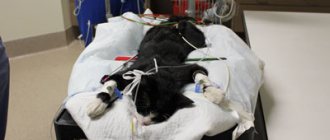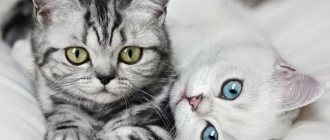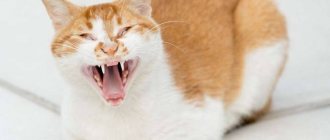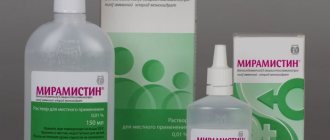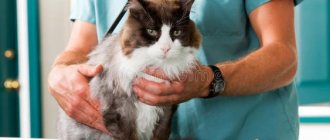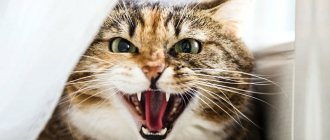Sterilization makes it easier and longer for cats to live, and reduces the risk of developing cancer pathologies. The operation is performed in different ways. The most traumatic type is an incision along the white line of the abdomen. The safest method is laparoscopy. Regardless of the method, complications may arise.
Often the operated pet has poor appetite or lack of it. If a cat does not eat after sterilization, this may be either normal or a sign of dangerous consequences.
How and what to feed a cat after surgery
You can feed your pet 24 hours after oophorectomy or ovariohysterectomy. The digestive tract does not work well for a day after surgery. The cat has not yet recovered from the anesthesia. She experiences nausea and may vomit.
Poor health after surgery is observed not only in females. Males also suffer the effects of anesthesia. If after castration the cat does not eat well, this indicates a weakness of the body, the development of inflammation, and an allergy to medications.
When preparing a postoperative diet, you need to take into account how and what the animal ate before surgery. Industrial feed is the most acceptable option, since all components are balanced in them. When feeding natural food (fresh meat with a small amount of cereals and vegetables), it is difficult to achieve the correct ratio of nutrients. Homemade food is not an acceptable type of nutrition. Cats and cats are obligate carnivores, they need special vitamins and nutrients.
Preparation
When preparing for the examination, you must adhere to a number of rules:
- The day before your scheduled procedure, follow a low-carbohydrate diet.
- Come to the examination on an empty stomach.
- On the eve of the study, avoid heavy physical activity.
- On the day of the procedure, drink plain water.
- Stop chewing gum.
- Come to the procedure in comfortable, comfortable and preferably warm clothing.
It is recommended to bring information about the disease, diagnoses, extracts from other hospitals, results of other studies, etc. to the research procedure.
First day
For 24 hours after castration, the cat does not eat anything and sleeps a lot. This is normal, because... the pet is exhausted, has lost 15-20 ml of blood, and therefore does not show interest in food. To digest food, energy is needed, and the operated animal has little of it, because... strength is spent on restoring the body.
12 hours after surgery, the cat can drink.
If at this point she is still half asleep, it is recommended to wet her lips or drop a few drops of water on her tongue. This will prevent your mouth from drying out and protect you from dehydration.
Wound care and treatment
Postoperative sutures usually do not cause discomfort to the animal. But curiosity takes over, so often the cats themselves become the culprits of unpleasant consequences. Therefore, you should not let your cat disturb the wounds. A little effort is also required from the owner to ensure that the animal endures the adaptation period after surgery as easily as possible.
Simple tips to help you heal quickly:
- Treat seams with brilliant green or hydrogen peroxide at least 2 times a day. As a supplement, you can use levomekol ointment; it is used as an antibacterial and healing agent.
- To prevent the animal from touching the surgical site, wear a special diaper.
- A five-day course of antibiotics to prevent infection.
Cats' bodies are very similar to humans, so provide them with care and attention. Even small wounds need to be treated, and even more so after surgery.
The appearance of pathogenic bacteria can only be avoided by treatment.
If all this is done, then in a short time the animal will begin to delight its owners with a wonderful mood.
Second day
The second day is indicative. The pet should begin to show interest in food and water.
It is recommended to feed the animal with special canned food, which is intended to restore the body after illnesses and operations.
Veterinary diets during the recovery period are produced by companies such as:
- Hill's;
- Monge;
- Purina;
- Royal Canin.
If the cat eats natural food, on the second day it can be given chicken broth with a small amount of chopped meat, offal and vegetables.
If your pet still refuses to eat or drink, you need to pay attention to:
- body temperature;
- condition of the seams;
- color of mucous membranes.
If there is a change in body temperature, the presence of redness, swelling and swelling in the area of the sutures, or blue discoloration of the mucous membranes, you should consult a veterinarian.
Indications for the study
- Search for the primary tumor site when metastases are detected;
- Determination of the stage of the oncological process;
- Differentiated diagnosis of relapse and post-treatment changes;
- Monitoring the course of the disease, detecting relapse;
- Planning of radiotherapy and surgical manipulation;
- Planning a biopsy and finding the most aggressive area of the tumor.
Radiofrequency ablation of liver metastases
Fourth day
A situation where an animal refuses food for 4 days is unlikely. If this happens, this indicates severe pathologies:
- sepsis;
- peritonitis;
- gastrointestinal diseases (for example, intestinal atony).
A cat that doesn't eat for 4 days in a row is most likely dying. She needs urgent veterinary attention.
It happens that the first few days everything is fine with appetite, but on the 4th day it disappears. This may be due to delayed intestinal atony or the reaction of the liver and kidneys to the administration of anesthetic drugs.
Radiation exposure to the patient during examination
The choice of radiation dose is influenced by the radiopharmaceutical used and the scope of the study. So scanning the head requires less radiation than scanning the whole body. Minimizing harm from using the method is achieved if the following requirements are followed:
- Use isotopes with a half-life of several minutes or hours;
- Calculate the dose individually for each patient, taking into account his age, height, weight;
- Use special filters on scanners, as well as programs that reduce radiation doses;
- Consume the required amount of fluid, this will allow you to quickly remove the radiopharmaceutical from the body
By contacting the Onco.Rehab integrative oncology clinic, you will find out where it is best to undergo the study that we told you about in this article.
What to do if your cat has no appetite
Caring owners begin to worry when their pet eats poorly or completely refuses to eat. In such a situation, the question arises of what to do and how to help the cat.
If symptoms of severe pathologies are not detected, and the animal itself behaves and feels normal, then no special treatment is required.
To improve appetite and strengthen the immune system, you can take intravenous injections with saline glucose solution for several days. It is recommended to administer vitamin preparations intramuscularly. Such injections will help the body recover faster.
You can add glucose solution or sugar to drinking water. These substances stimulate appetite and increase vitality.
Changes in the lifestyle (feeding, maintenance) of a neutered cat
Neutered animals are prone to obesity. In order to prevent your four-legged pet from becoming overweight, it is recommended to switch it to a lower-calorie diet at the end of the rehabilitation period. If your pet eats ready-made food, you should replace it with a product marked “for sterilized (neutered) cats.” It is better to agree on the brand with your veterinarian. It is useful to give your animal fasting days about 2 times a month.
If the cat's diet consists of natural products, it is necessary to reduce the cat's intake of phosphorus, calcium and magnesium, since their increased content in her menu can lead to the formation of kidney stones. Drinking plenty of fluids will help prevent the development of urolithiasis. There should always be clean water in the cat's water bowl. In order for your cat to use up the energy accumulated during the day, you need to play with it every day or take it for long walks. Various toys and a play complex will help keep her occupied.
Possible pathologies
If a pet does not drink for several days, refuses food, and is lethargic and lies down most of the time, this indicates the development of severe complications.
After sterilization, the following dangerous pathologies are possible:
- intestinal obstruction or atony;
- peritonitis (inflammation of the peritoneum);
- sepsis (blood poisoning);
- postoperative hernia;
- seam divergence;
- infectious inflammation and suppuration of sutures;
- renal or liver failure.
For the above complications, treatment at home is not always possible. In most cases, the animal must be taken to a veterinary clinic.
Consequences of sterilization
Owners should be concerned about the following consequences of sterilization:
- lethargy and apathy;
- impaired coordination of movements;
- excessive thirst;
- unnatural posture when the pet is lying down;
- desire to hide, photophobia.
The animal’s need for fertilization should also be of concern. This is possible with incomplete castration, when the ovaries continue to function, but the cat cannot become pregnant. Nevertheless, she wants to.
Sometimes after sterilization, cats begin to mark their territory. This is caused rather by psychological reasons: this is how they assert themselves, because the reproductive instinct has been lost. This habit may go away over time, otherwise the animal will have to be weaned off it.
If a pet meows loudly after surgery, she reports that she is in pain and uncomfortable.
Veterinarian advice
A sterilized cat may not eat for 2 days. Calorie reserves will be enough to provide the body with nutrients for this period.
Veterinarians recommend waiting and not force-feeding your pet. If after 2 days the cat does not have an appetite, it should be shown to a doctor.
Further advice from veterinarians is individual and depends on the diagnosis that will be given to the animal.
All information posted on the site is provided in accordance with the User Agreement and is not a direct instruction to action. We strongly recommend that before using any product, you must obtain a face-to-face consultation at an accredited veterinary clinic.
Danger of dehydration
Water makes up 65% of a cat's total body weight. With its help, nutrients and oxygen are transported to the tissues of the body. If there is insufficient fluid supply, this process slows down, and the lack of oxygen leads to cell death and disruption of system function.
Dehydration leads to an increase in the concentration of toxic substances in the blood and urine, which negatively affects the functioning of the kidneys and liver. Without receiving the proper amount of moisture and oxygen, certain areas of the brain gradually begin to die, which is accompanied by nervous phenomena, loss of coordination, convulsions and paralysis.
